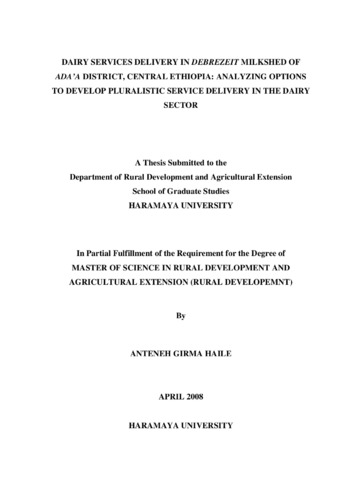Dairy services delivery in Debrezeit milkshed of Ada'a District, Central Ethiopia: analyzing options to develop pluralistic service delivery in the dairy sector
Abstract
Ethiopia’s rural development policy and strategies place in centre stage the transformation of smallholder subsistence agriculture to market-orientation to promote commercialization of the sector. Smallholder dairy production contributes 50 % of the livestock output and about 30 % of employment, with still a large untapped potential. Despite a plethora of projects and expressed policy intent, the dairy sector did never really take off. One of major bottlenecks as revealed by many studies is problems related to coverage, responsiveness and efficiency of supportive service delivery. Multiple service providers -public, private and third sector- are increasingly emerging in the dairy sub-sector, which calls for effective and efficient coordination mechanisms and enabling policy environment. The pluralistic service delivery framework was used to analyze the functioning of pluralistic service delivery system in Debrezeit milkshed, which has relatively developed and market-oriented dairy systems. In the milkshed, dairy sector is currently in a transition towards market-orientation, with private sector investment and multiple actor involvement in the service delivery. This district also houses the most advanced and largest dairy co-operative in the country. Primary data was collected from 150 randomly selected smallholder dairy producing households located in urban, peri-urban and rural areas; and also from various service providers. The data generated by Rapid Appraisal of Dairy Innovation Systems by IPMS project in Ada’a and review of government policy and strategy documents supplemented information generated by household survey. The results reveal that while the dairy service provision is mainly dominated by the public sector, the roles of private sector in providing animal feed, product marketing and processing, micro finance, veterinary services are increasing. However, there is no mechanism to coordinate multiple service providers for them to effectively function as a system. Forage seed/cutting material supplier and vet clinical service providers in the peri-urban and rural sub systems whereas dairy advisory service providers are among the missing actors in the milkshed. In addition, the public sector lack competence to facilitate financial and market links and regulate services and accredit the private service providers in the milkshed. The policy and institutional analysis revealed that existing government policies and strategies are important steps forwards for the commercialization of the sector with out any restriction on non public service providers to participate in the market. Nevertheless, success in pluralistic dairy service delivery, among others, is constrained by inadequacy of the existing policies and strategies (lack and/or delay in the livestock policy and no division of public and private role in animal health service), still more enabling environment and institutional arrangements setback. Policies are required to reconfigure roles of the public sector to take up the missing role or encourage non public actors to play it and avail clear policies that as to what type services to be provided by the public and non public sector. In addition, the required favorable conditions for the promotion of non public actors needs to became visible. This study analyzed cost sharing as an option for developing sustainable and responsive service delivery, by assessing producers’ willingness to pay for advisory service using Contingent Valuation Method (CVM) method. Results show that 71.3 % of the producers described themselves as willing to pay for dairy advisory service if their income from dairy would increase. While exploring options for development of a functional and effective pluralistic service delivery system to support the commercialization of smallholder dairy production, this study comes up with options for providing and financing dairy related services that involves the public, private, and third sectors.

